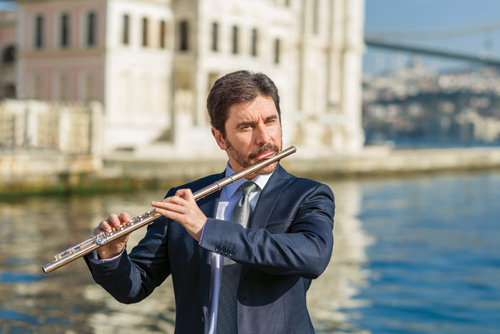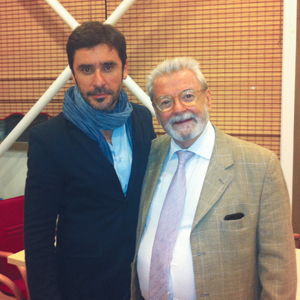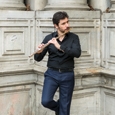
Bülent Evcil wants to increase the popularity of the flute in Turkey and to represent Turkish flutists in the world arena. He is the solo flute of the Istanbul State Symphony Orchestra and the Istanbul Borusan Philharmonic Orchestra, and performs and teaches throughout the world. He began his studies with Mükerrem Berk at the State Conservatoire of Mimar Sinan University graduating in 1988 with the highest distinction. He continued his studies at the Royal Brussels Conservatoire with Marc Grauwels and Heidelberg-Mannheim Music Academy with Jean-Michel Tanguy. In 1992, Evcil won the second prize of the Best Overall Performer Award at the 4th James Galway International Flute Seminar in Dublin which led to his studies with Sir James Galway. Evcil has performed at flute festivals and conventions in Italy, England, United States, Slovenia, France, Kosovo, and Germany. He has released three albums Tango Zamani, Middle Eastern Miniatures, and The Virtuoso Flutist.
Kemal Atatürk was a great innovator and leader in Turkey. What was his influence on the arts in your country?
If Atatürk had not lived, I would not be here and replying to these questions as a musician. (Kemal Atatürk was a Turkish army officer and the first President of Turkey. He is considered the founder of the Republic of Turkey.) He instituted a series of initiatives in the first years of the Republic. On April 27, 1924 the first orchestra was founded in Ankara. On September 1, 1924, the first conservatoire opened its doors with six students and a mission to develop Turkish contemporary music. In ten years there were music schools in Ankara and Istanbul, an orchestra and a band in Ankara, and school and community center choirs. This was an achievement because Turkey was a poor country that had just come out of war.
German professional musicians were imported to help with the musical development of the country. Paul Hindemith visited between 1935 and 1937 and paved the way for more German experts to come to teach and perform. Today, besides the top professional orchestra, there are six symphony orchestras and six opera orchestras plus many conservatories and music departments at universities.
What involvement have your parents had in Turkey’s musical life?
My father is an extremely idealistic and successful music teacher. He worked with my mother who is also a music teacher in the village institutes. Unfortunately in the 1950s these institutes were closed down. In 1985 my father tried to revive Atatürk’s original concept of music education by preparing reports and regularly visiting Avni Akyol, a childhood friend and the Minister of Education of that term. Finally he managed to convince him. On October 16, 1989, the first fine arts high school opened. Today, there are almost 70 of these high schools. These schools are having a major influence in bringing music and the arts to the public.
How do you think your parents’ involvement with music affected your artistic development?
My parents founded polyphonic choirs in the music academies where they used to work. They competed in competitions and received prizes. They used to play and sing the polyphonic choir and orchestral works at home, and classical music was always on the radio. Since I grew up singing in choirs, singing was not difficult for me. Playing the flute to me is really singing through the flute.
How did you select the repertoire for your new recording The Virtuoso Flutist?
The recording includes repertoire by Borne, Chaminade, Morlacchi, Godard, Briccialdi, and transcriptions of violin works by Sarasate, Monti, and Rimsky-Korsakov. No Turkish artist had made a recording of these virtuoso pieces before. I wanted to record this literature to provide inspiration for the new generation. I selected repertoire that I hope would get them fired up about the flute and flute playing. The Morlacchi, Borne, and Chaminade are always in my repertoire. I also wanted to put in some pieces from the violin virtuoso repertoire that I admire. Since one of my goals is for virtuoso flute playing to compete with virtuoso violin playing, I included the Sarasate and Monti which transcribe well for the flute.
I have known Philip Moll who accompanied me on piano for the recording since I was a boy. He watched my progression as I was learning and maturing as a flute player. I admire him as an accompanist, not only because he is a living legend, but also because he is a warm-hearted musician of the world. Working with him and giving concerts with the pieces on this CD was a great pleasure. He was also a mentor by sharing his experiences and education.
What was your best lesson ever?
I cannot say there is only one lesson. With every lesson I took from Sir James Galway, I received some information from his knowledge and experiences that were turning points in my life. From Raffaele Trevisani I learned about breathing. Lessons with J.M. Tanguy in Germany and Marc Grauwels in Brussels were important milestones in my life. Last year I played a concert with Davide Formisano. I learned so much playing Baroque music with him. That proves you are never too old to learn.
 What were lessons like with Galway?
What were lessons like with Galway?
I had my first opportunity to play for him in 1989 when I was 21 years old. The second time that I gained his attention, I played the Khachaturian Flute Concerto by heart for him including his cadenza. When he asked where I had found the cadenza, I told him I took it off his recording by ear. He was really surprised. Then he started our master-apprentice relationship by giving me the Khachaturian cadenza music as a gift. This happened at an international masterclass, and the Swiss media was there. He spoke highly of me before the press which made me so happy. Being his student was my biggest dream.
He is a generous person and mentor. One time he came to Turkey to play a concert. At that time, I had an old Fiat 124. The concert venue was about 45 minutes away. The concert organizer had arranged for Sir James to travel in a luxury vehicle with a driver, but he said since I had come a long way to see him, he would ride with me in my modest car.
While I was studying in Brussels, he sent me information about concerts he was giving in the area so I could attend. He made time after these concerts to teach me, and if there was an after concert gathering, he took me along with him. He is well-read and has ideas not only about the flute, but also about history, politics and human relationships. He also often took care of my travel expenses including my food. I learned a lot from him, not only about playing the flute.
In addition to Galway, Mark Grauwels in Brussels, Jean-Michel Tanguy at the Mannheim Music Academy, and Professor Mükerrem Berk, who inspired me to begin music study, are the most important people in my musical life.
How does Galway teach the general set up for playing the flute?
Generally his left foot is in front, and the right foot is in back. He balances the flute in three anchors: the right hand thumb, the left hand’s balance point, and the embouchure which merges in the lips. This positive posture mimics that of a self-confident famous opera artist. The air flow and projection process positively with this posture.
His teaching is based on what he has learned by giving many concerts. I was getting ready to play a concerto with an orchestra, so I went to him for help. I was totally prepared and had memorized my part. I had actually memorized my part so that I could begin playing from any point. I could even notate the music and the orchestration was in my ears.
I started playing and made a mistake at some point. He stopped me. I thought that I would start again from there, but instead he asked me which orchestral notes were played there and on which instruments. I was extremely surprised. Then he told me the notes and the instruments to be played at that point and said, “Bülent, know the whole orchestra score, not only the flute parts.” Since that day, I have tried to learn the whole score of whatever I play.
What led to your recent Turkish premier of the Lowell Lieberman Concerto for Flute and Orchestra?
The Lowell Liebermann Concerto was premiered by Sir James Galway with the St. Louis Symphony Orchestra on November 6, 1992. I heard this work for the first time when he was preparing for that concert, and I was impressed. It has been my dream to premiere the work in Turkey since that day.
Mr. Liebermann is a friend from social media, so I informed him about this premiere. I will also send him the recording of the concert. I think I did a good job. The rhythmic changes in the first movement are not difficult for a Turkish player because Turkish music involves many unsystematic rhythms. The second movement is so expressive, and the third movement is exciting in its brilliance. It is impossible for an audience not to get influenced with it. If you play with a clear and fluent power, the impression is doubled. The Turkish audience loved it. My new goal is the Turkey premier of Liebermann’s Concerto for Flute and Harp.
What are your thoughts about using breath?
When we are talking or singing, breath taking is very natural and silent. However while playing flute, many flutists breathe loudly. In my student years when I observed my tutors, I saw that the virtuoso players were breathing silently and naturally. I tried to implement this type of breathing in my playing. I work with students to breathe naturally and silently. It prevents the throat from closing, so air flows naturally from the lungs. This type of breathing makes a sound which is more homogeneous and ensures that the sound is under control in a flexible way.
Do you have any special warm up exercises or techniques?
Marcel Moyse De La Sonorite is my favorite. I also use the tone exercises by Sir James from his Weggis classes. Technically I do the major and minor scales in different articulations plus work in all three octaves. The exercises I make up help me overcome any difficulties I find in my solo, chamber, and orchestral repertoire. You have to think big while practicing. You have to practice as if you are playing a huge concerto in Carnegie Hall with the New York Philharmonic. You must consider every aspect such as musicality, articulations, and your perfect sound. Brain power is extremely efficient while doing this. In addition to flute exercises, I am also interested in fitness. If I can spare time, I go to the gym and if I can’t, I do sit-ups and push-ups at home.
Do you play in a woodwind quintet?
I play in a woodwind quintet made up of the principal players of the Borusan Istanbul Philharmonic Orchestra. The name of the ensemble is Bosphorus Quintet and it is named after the unique Bosphorus of Istanbul. On our last program we played Rossini’s Barber of Seville Overture, Ibert’s Trois Pieces Breves, Taffanel’s Quintet for Winds, Debussy’s Children Corner’s Suite, Rota’s Petite Offrande Musicale, Agay’s Five Easy Pieces, and Bizet’s Carmen Suite.
What are your best memories from your first few years as an orchestral musician?
My best memories are from the period that I played as the principal flute in Arturo Toscanini Philharmonic under the baton of legendary conductor maestro Lorin Maazel. He was an unbelievable conductor. The intensity of emotions he made me feel while conducting was amazing. His desire to reveal the talent in me always made my hair stand on end and made my eyes water. I became an utterly different orchestra musician after working with him.
Another memory that I cannot forget is the Japan tour we made with the Istanbul State Symphony Orchestra. The whole audience in the famous Suntory Hall embraced us by applauding the orchestra without interruption for 20 minutes. Most of the musicians’ eyes were filled with tears. It was unbelievable.
My young flutist friends who aim for an orchestra career should listen to orchestra repertoire frequently. When I wake up every morning and go to the rehearsal of my orchestra, I think how many people in the world can be as happy as I am to do this job and how lucky I am. If young musicians can reflect this happiness in their playing, this energy will definitely be felt in the auditions.
Students should learn the entire flute part in all orchestral repertoire. They should study the complete orchestral scores too. I would also recommend memorizing some main solo parts. For example the solos in Brahms’ Symphonies Nos. 1 and 4, Mendelssohn’s A Midsummer Night’s Dream, Ravel’s Daphnis et Chloe, Stravinsky’s Petrushka and Firebird, Prokofiev’s Classical Symphony, Debussy’s Afternoon of a Faun, Hindemith’s Symphonic Metamorphosis, and Beethoven’s Symphony No. 3 “Eroica” are the first ones that come to my mind. Of course, they should study the excerpts with experienced orchestra flutists and conductors if they can. Orchestra conductors can offer many ideas to young flutists based on their experiences. I recommend flutists learn to play the solos by heart. Sir James used to demand entire solos from memory.
Do you think about playing the flute differently in orchestra than as a soloist?
I play orchestral solos like a soloist, but with tutti parts I blend with my section and the orchestra. At the beginning of my orchestra career, I played too much like a soloist. You must study the complete score to understand your role in the composition. Sometimes you have to blow chords without using vibrato when playing in the orchestra.
When playing as a soloist or orchestral flutist, I keep my overall sound the same but use different tone colors. Sound differences can happen in recording sessions, but of course this is also related to the sound technician’s competence. Generally I have my own sound in my ear, and I can hear that in most of my recordings. Turkish Radio Institution records our concerts every week, and I regularly listen to these recordings and do my own criticism about things to be fixed, developed, or that I should be more careful of etc. Recording and listening to your own sound is very important. I am trying to do this as much as I can so that I can evaluate myself and become better.
What are your goals for your summer masterclass?
This summer I am organizing a summer school for flute at the Gümüşlük International Classical Music Festival held in Gümüşlük, a town on the Bodrum peninsula which is one of the most beautiful places of Turkey. Last year Philip Moll came, as he will again this year, to share his talent. I plan on holding this masterclass every summer for as long as possible. The class will be August 4-12 this year.
Why are amateur musicians so important?
Amateur musicians connect society and professional musicians. Often professional musicians are focused on practicing and performing for their jobs, so it is the amateurs who bring our cause to the public. This has happened to me many times as my amateur musician friends have connections that help me perform concerts and give masterclasses. Having a connection with people without the consideration of language, religion, race, professionalism or amateurship is
crucial.
I want to increase the number of flutists in Turkey at all levels, including professionals, amateurs, and audience members. For this reason, I travel all around Turkey, even when I do not receive money to play, and give lessons. I am trying to reach the masses and introduce classical music to them with the huge energy and love that is inside me.
* * *
Scale Practice with Articulation Patterns
On the scale play with each of the following articulation patterns.
.jpg)
Photo credits: cover image on home page: SEZAI KOCABIYIK, other photos by BULENT OZGEREN.






